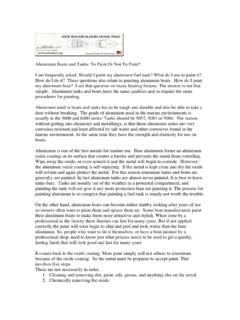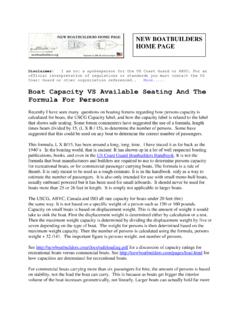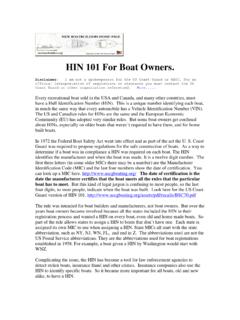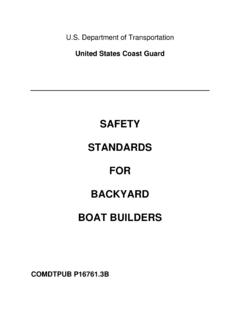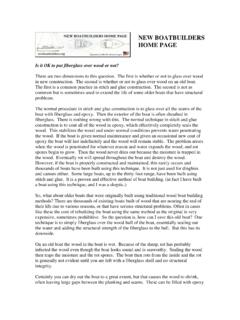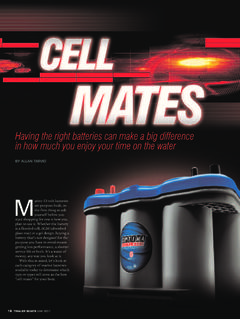Transcription of STABILITY OF SMALL BOATS - newboatbuilders.com
1 STABILITY OF SMALL BOATS One of the more frequent problems to come up during my years in the Office of Boating Safety, was BOATS that had a list. These were new BOATS that were tender, that is tippy , and had a list sitting at the dock, and sometimes when underway. I am only going to discuss the static condition; that is, standing still. When a boat has STABILITY problems underway that is called dynamic instability and is a much more difficult problem. Generally the owner would say the boat lists to one side, usually to starboard, and seems to be unstable. The boat scared them. My first question was usually did it do this when you first got it? . More often than not they said yes, but sometimes it was a simple matter that they had loaded all their stuff on the boat and needed to redistribute the weight.
2 One fellow had 20 cases of soda on his flying bridge. But what about the boat that came that way? STABILITY of SMALL craft is a subject that is often not understood by owners and misunderstood by the builder. Most of these BOATS are deep vee, with a vee bottom of 10 to 20 degrees, occasionally more. They are narrow beam so they can be trailered and have high sides for offshore work. In fact, most of the ones I dealt with were offshore center or side console, fishing BOATS . To make matters worse when the owner complained, often the solution by the builder was to add lead weights to the opposite side of the boat . This reduced the freeboard aft, reduced the load capacity and speed. Some of these BOATS have a transom door or false transom and when the extra weight is added the waterline is very close to the level of the deck aft, meaning the wake comes aboard when the boat slows down or when hit by a following sea.
3 The weights they added were usually placed low in the bilge to attempt to lower the center of gravity. This can often make the situation worse. The problem here is two fold. The first problem is the design of the boat , second is a weight distribution problem. STABILITY is determined by the relationship between three things, center of gravity (CG), center of buoyancy (CB), and something called metacentric height (GM). Also we need to know the difference between initial STABILITY and reserve buoyancy. First a few definitions: Center of gravity is the point in the boat where all of the forces of gravity (down) are equal. In other words if you could balance the boat on a point, this would be the point where it balances.
4 Center of buoyancy is the point where all the forces upward from the water are acting. It is essentially the center of the underwater volume of the boat . NEW BOATBUILDERS HOME PAGE Initial STABILITY : A measure of the boat s ability to right itself at low angles of heel. A boat that lists to one side or the other when sitting at the dock and feels tippy to the owner, has low initial STABILITY . But this boat once heeled may have high reserve buoyancy. Reserve buoyancy: A measure of the increase in buoyancy and STABILITY as the boat heels over. A boat with large reserve buoyancy tends to right itself, easily and quickly, while a boat that has low reserve buoyancy tends to come upright very slowly or not at all.
5 Normally, under static conditions, if you draw a vertical line upward from the center of buoyancy it will pass through the center of gravity. At rest with no heel, the center of gravity should be directly in line vertically with the center of buoyancy. A metacenter is an imaginary point at some height above the CB and CG of the boat . If you imagine the boat as pendulum swinging from a line, the point it is swinging from would be the metacenter. Or; if you draw an imaginary line vertically through the center of buoyancy and the center of gravity, then lean the boat a few degrees and again draw an imaginary vertical line through the center of buoyancy, the point at which these two imaginary lines meet above the boat is the metacenter (M).
6 As the boat heels, the shape of the immersed portion of the boat changes, and the center of buoyancy moves outboard. The center of buoyancy is no longer under the center of gravity, and the center of gravity should be inboard of the center of buoyancy tending to right the boat . is not to scale and is for illustration purposes only. If you measure the distance the CB moves outboard, and subtract the distance the CG moves outboard, the difference is the righting arm. The longer the righting arm the higher the righting moment, or the force pushing the boat upright. If the CG is farther outboard than the CB and the difference is negative the boat rolls over. The height of this point above the center of gravity is GM, the metacentric height.
7 If you compare the length of GM to the distance between the center of buoyancy and the center of gravity, and the GM is a lot longer, then you have a stiff stable boat that easily stays up right. As GM gets shorter the boat rolls more easily. If GM is negative, that is, below the center of gravity then the boat is unstable and leans to one side or the other. The side it leans to depends on the weight distribution on the boat . The ideal is to have a boat that has a gentle roll but only goes so far, maybe 30 degrees at the most and rights itself. As a boat leans over the shape of the part of the boat underwater changes, and if the boat has flare, that is, the side leans outward at an angle, it again becomes more stable, because the center of buoyancy moves outward towards the way the boat is leaning.
8 But the center of gravity of the boat doesn t (If there are no people in the boat , or the people don t move). GM changes and becomes positive and the boat becomes stable, but is stable leaning to one side. As illustrated in the above diagram, as the boat heels the Center of Buoyancy , CB, moves outboard to CB1 and then CB2, The righting moment, that is the force tending to right the boat increases. This is what is called reserve buoyancy, the ability of a boat to gain STABILITY as it leans over and has more resistance to leaning farther. The flaw in the BOATS that heel sitting at the dock is that in normal conditions GM is near zero or slightly negative and there is no righting moment Adding weight causes the boat to sit a little deeper and moves the center of buoyancy slightly upward and the center of gravity slightly downward and makes GM a little more positive, if you add the weight low in the boat about the same height as the designed center of gravity, or put so much weight in that the CG moves below the CB.
9 If you put it higher than the existing CG it can have negative effects, actually making GM shorter and causing the boat to list more. This gets worse when a person steps on board. The center of gravity of the human body varies from person to person but on an adult standing up is generally somewhere in the midsection of their body, about 3 feet above the deck they are standing on. By adding the body s weight to the boat you significantly raise the center of gravity of the boat , and slightly raise the center of buoyancy, reducing the GM and maybe even making it more negative causing the boat to heel even more, Until it heels to a point where the center of buoyancy shifts farther outboard than the CG and the boat starts to gain righting moment; the tendency to right itself.
10 This assumes the person is standing on the center line and doesn t move. If they move toward the low side, the CG moves that way too and the boat leans more (sounds obvious and it is) and the CB shifts outboard as well. However, if the CG shifts more outboard than the CB then the boat rolls over. The real solution is to change the design of the boat . Give it less of a vee, make it wider at the waterline, and move things in the boat so the CG is lower but CB is the same. But how do you fix an existing boat ? The best solution is not to add weight. The best solution is to move things around in the boat so that the weight is distributed in a way to lower the center of gravity. It doesn t necessarily have to be below the center of buoyancy but by moving it closer to the center of buoyancy you increase the GM.
